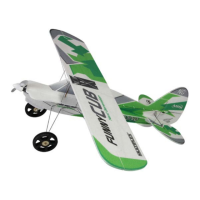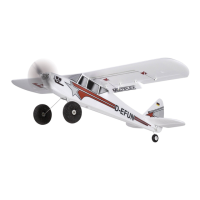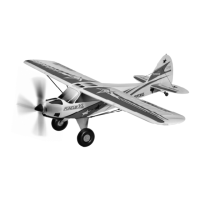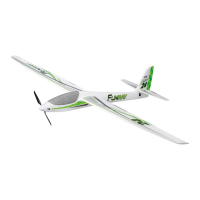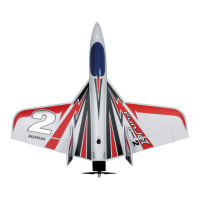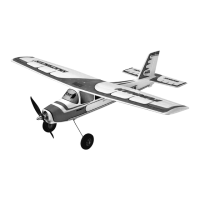18
Assembly instructions
1. Before assembly
Check completeness of the parts supplied using the list of parts on pages
14 to 16 and
Fig. 1 & 2
.
We recommend using a soft, clean and at surface to ensure the model is
not damaged during assembly. Always use, unless otherwise specically
stated, our Zacki2 ELAPOR
®
# 1-01291 CA instant adhesive.
We recommend lightly sanding all contact points before gluing to ensure
good adhesion of the adhesive. This applies both to foam on foam and
plastic on foam bonding.
2. Preparing fuselage halves
Initially glue the fuselage belts
into the fuselage halves
and
.
For gluing, rst apply some Zacki2 ELAPOR
®
into the recesses, then
press the belts into the recesses, e.g. using a screwdriver. Subsequently
apply some Zacki2 ELAPOR
®
along the belts.
Then feed the motor mount
and the wing strut bracket
onto the
square tube
. Insert this unit “dry” into the right fuselage half and use
a pencil to mark the positions of the parts on the CFRP tube. Now glue the
plastic parts onto the tube and the unit ush into the right fuselage half.
Press the motor mount and the wing strut bracket rmly into the fuselage
half. Also glue in the locking clips
. Insert one M5 nut
in each
wing counter bearing
and glue the two bearings into the fuselage so
that the thread is in the middle. Make sure that no adhesive enters the
thread.
Fig. 3 & 4
3. Preparing the fuselage servos
Now use the remote control or a servo tester # 1-01359 to set the two
servos for elevator and aileron to the neutral position (1500 µs) and then
mount the servo arms at right angles (90°) to the servo housing.
Caution: Due to the uneven number of teeth, the servo arms cannot
be shifted by 180° exactly. Try out both positions to ensure the
servo arm is screwed tight as exactly as possible to the 90° position
afterwards. Position both servos alongside one another and rst cut
the left and then the right servo arm evenly. This can be done most
effectively using a small side cutter.
Glue the servos to the tabs in the fuselage halves according to
Fig. 5 & 6
Secure the servo cables in the shafts with a few strips of masking tape to
ensure that no cables are in the way or trapped when the fuselage halves
are glued together.
Fig. 7
Caution: Secure the servo plug-in connection with a small drop of
Zacki2 ELAPOR
®
to prevent them becoming loose.
4. Gluing the fuselage halves together
Make sure that all components are in the correct position and “dry” t the
two fuselage halves together as a test. Apply sufcient Zacki2 ELAPOR
®
to the contact points of the right fuselage half. Now take the left half and
join both parts together.
If necessary, use a cloth to wipe off any escaping instant adhesive. Be careful
not to bend the fuselage halves to avoid distortion or misalignment. Allow the
adhesive to ash off sufciently before continuing with the next step
.
Fig. 8
5. Gluing on the tailwheel hinge
Glue the tailwheel hinge fuselage
onto the fuselage tail.
Fig. 9
6. Gluing in the tailplane
First glue the rudder horn
into the elevator
Fig. 10
. This must
be done very carefully. It is best to sand and degrease the plastic parts
beforehand. This also applies to all other hinges and rudder horns.
The tailplane can then be glued to the fuselage. Apply Zacki2 ELAPOR
®
to the fuselage contact surface and then attach the tailplane
Fig. 11
.
The tailplane must be positioned horizontally on the fuselage
Fig. 12
.
7. Gluing in the vertical tail
Initially assemble the pushrod connector, consisting of the parts
, on the tailwheel hinge-rudder
(Fig.13). Do not tighten
the nut too much. It must be possible to rotate the pushrod connector
slightly. Secure the nut with a small drop of Zacki on the free threaded
piece. Check movement of the pushrod connector again.
The entire unit can then be glued onto the rudder
. The vertical tail
can now also be glued to the fuselage
Fig. 14
. Apply adhesive to the
pockets on the tailplane and the contact surfaces, feed the tailwheel hinge
together, insert the tailwheel wire
to ensure a concentric axis position
and press on the vertical tail. Pay attention to a 90° right angle
Fig. 15
.
When the adhesive has dried, the tailwheel wire can be removed again; it is
assembled properly in the next step.
8. Undercarriage assembly
Pre-assemble the tailwheel according to
Fig. 16
and attach the unit to
the fuselage
Fig. 17
.
First loosely assemble an undercarriage mount
(without adhesive)
from above through the canopy cutout on the GRP square tube in the
fuselage and use a pencil to mark the correct position.
Make sure the position of the undercarriage mount allows the main
undercarriage to slightly protrude through the bottom opening of the
fuselage. Now glue the part
into place
Fig. 18
. After the adhesive
has set, assemble the main undercarriage
with the counter plate
and the four cross-head screws
on the fuselage. Assemble the
wheels
with the set collars
and the grub screws
according
to
Fig. 19
.
9. Assembling the pushrod
Hook the rudder pushrod
according to
Fig. 17
into the servo arm.
If you use the HS 65 servos recommended by us, the shown mounting
points can be used. To do so, use the set screws
and the included hex
wrench
. The tailplane pushrod is hooked in as displayed in
Fig. 20
.
EN
